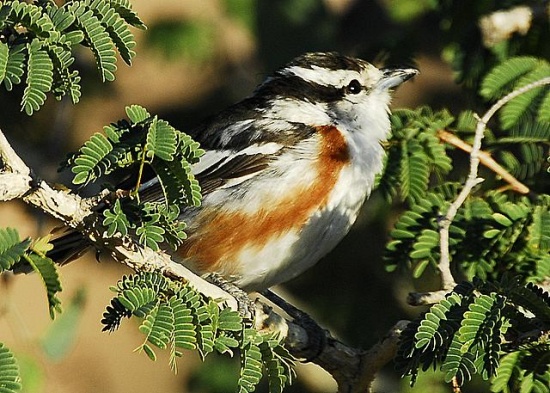- Nilaus afer
Identification
12–15 cm
Male
- Black back
- Tawny strip
- Mottled black rump
- White-tipped black tail
- Black crown
- White supercilium and forehead
- Black eyestripe
- Black wings with
- Buff to white shoulder stripe
- White underparts
- Rufous flanks
Female
- Duller and browner
- Streaked underparts
- Less rufous flanks
Juvenile
- Mottled brown, buff and white above
- Buff edged wings and tail
- White underparts with brown barring
Distribution
Widespread in Sub-Saharan Africa
Western Africa: Mauritania, Senegambia, Senegal, The Gambia, Guinea-Bissau, Guinea, Mali, Sierra Leone, Ivory Coast, Burkina Faso, Ghana, Togo, Benin, Nigeria, Niger, Chad, Cameroon, Central African Republic, Equatorial Guinea, Gabon, DRC and Angola
Eastern Africa: Sudan, Eritrea, Ethiopia, Somalia, Kenya, Uganda, Rwanda, Burundi, Tanzania, Zambia, Mozambique and Malawi
Southern Africa: Namibia, Botswana, Zimbabwe, South Africa and Swaziland (not found in the southern-most part of South Africa)
Taxonomy
Nilaus is a monotypic genus.
Subspecies
There are 9 subspecies[1]:
- N. l. afer: Senegal to the Sudan, Eritrea and Ethiopia
- N. l. camerunensis: Southern Cameroon and Central African Republic to eastern Democratic Republic of Congo
- N. l. minor: South-eastern Sudan to southern Eritrea, Somalia, extreme northern Kenya and Tanzania
- N. l. massaicus: South-western Kenya to northern Tanzania, Rwanda and eastern Democratic Republic of Congo
- N. l. nigritemporalis: Eastern Angola, south-eastern Democratic Republic of Congo, Tanzania, Zambia, Malawi, northern Mozambique
- N. l. brubru: Southern Angola to north-central South Africa
- N. l. solivagus: Swaziland, Zimbabwe and inland parts of eastern South Africa and southern Mozambique
- N. l. affinis: Central highlands of western Angola and adjacent southern Democratic Republic of Congo
- N. l. miombensis: Coastal parts of eastern South Africa and Mozambique (Sol do Save region)
An extra subspecies N. l. hilgerti is not recognised by all authorities[2].
Habitat
Open broad-leaved woodland, and acacia savanna. Generally found in the canopy.
Behaviour
Diet
The diet includes insects, including caterpillars, moths, beetles, ants and grasshoppers.
Breeding
They build a well camouflaged cup nest using twigs, grass and spider webs, decorated with lichens. The two whitish, greenish or greyish eggs have grey or brown blotches. They are incubated by both sexes for about 19 days; the young fledge in 22 days and are dependent on their parents for about eight weeks.
Brubrus are known to destroy their own nests when disturbed.
Vocalisation
Call: A repeated "brrr brrr ..." (hence the common name); similar to a ringing telephone.
References
- Clements, J. F., T. S. Schulenberg, M. J. Iliff, D. Roberson, T. A. Fredericks, B. L. Sullivan, and C. L. Wood. 2014. The eBird/Clements checklist of birds of the world: Version 6.9., with updates to August 2014. Downloaded from http://www.birds.cornell.edu/clementschecklist/download/
- Avibase
- Wikipedia
- BF Member observations
Recommended Citation
- BirdForum Opus contributors. (2024) Brubru. In: BirdForum, the forum for wild birds and birding. Retrieved 20 May 2024 from https://www.birdforum.net/opus/Brubru





